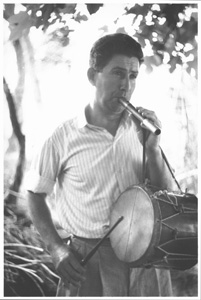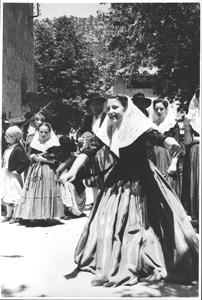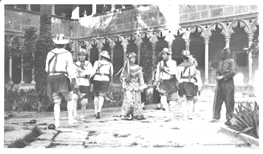|
Mallorca is the largest of the Balearic islands. Little is known about its earliest inhabitants. Around 1000 BCE the Talayotic civilization emerged, with its characteristic talayots, large semi-conical towers which can still be seen today. Greek and Carthagensian merchants visited the island; in fact, indigenous Balearic sling throwers helped the Carthagensians fight the Romans during the Second Punic War. The Romans took control of Mallorca in 123 CE, and the christianization of the island began. At the beginning of the tenth century the island was annexed to the Emirate of Córdoba, and a period of agricultural and commercial prosperity began, benefitting from the island’s strategic location between the Iberian Peninsula and the North African coast. In 1229 James I’s Catalan troops conquered Mallorca, which soon became one of the most thriving commercial and intellectual center of the Crown of Aragon. This lasted for over two centuries, with the lapse of some years when it was an independent state. The creation of Spain in 1492, uniting the kingdoms of Castile and Aragon, signalled the beginning of Mallorca’s decline in importance. The new government forbade the islands from trading directly with the Americas, which had just been “discovered”. The expulsion and the establishment of the Inquisition annihilated the Jewish population, already greatly diminished since the massacres of 1391. During the following centuries, several epidemics made the situation even worse. In the eighteenth century, Spain introduced the Decree of Reorganization or “Decree of New Disposition” (Decret de Nova Planta) which rendered Mallorca’s legal system and institutions void and began the persecution of the Catalan language, which it sought to supplant with Castilian Spanish. In the nineteenth and twentieth centuries, drought, hunger and epidemics pushed many Mallorcans to leave their home and emigrate to the Americas. In spite of all these problems, renewed communication with peninsular Spain, the introduction of the railroad, and agricultural improvements alleviated the situation and brought about a revival, albeit a somewhat limited one, of Catalan culture. In 1936 General Francisco Franco led a coup d’état which opened the way to civil war, to the end of the Second Republic at the close of the war in 1939, and to forty years of dictatorship. Ever since the Decret de Nova Planta, and even more so during the Franco dictatorship, the Spanish government had exercised rigid and unyielding control over the country’s non-Castilian cultures. This was evident in the folklore of the period of the dictatorship. Often, organizations such as the Sección Femenina de la Falange Española (the Women’s Branch of the Spanish Phalanx) organized and promoted performances of “folk” music and dance conveniently aimed at tourists and for the public affiliated with the dictatorship, though in reality these performances were often far removed from their original manifestations. With the beginning of mass tourism in the 1960s, thousands began to visit the island’s beaches, and the standard of living rose to be one of the highest in Spain. This all came at a high price: excessive construction, together with destruction of the countryside, have spoiled most of the coastal areas. With the fast disappearing rural culture, Mallorca’s traditional music was in its hardest hours. In 1975 the dictatorship ended and constitutional monarchy was restored to Spain. The new democratic laws gave Mallorca more autonomy, although the recovery of Catalan culture is still being curtailed by aspects of Spanish law and political practice. The last twenty years have brought about major changes in Mallorcan traditional music, in many cases alongside efforts to recover Catalan language and literature. The dances presented in earlier periods as “folk” in performances aimed exclusively at tourists, with period costume, are being rapidly displaced by all kinds of folk and popular melodies, with people of all ages actively participating in dances, dressed in everyday clothes, though often both models coexist. Despite the rapid demographic change linked to the touristic explotation, something is changing: schools offering courses in traditional dances and instruments are appearing, as are new ensembles, performing the older repertoire, often along with new compositions using old forms. Especially interesting is the resurgence of the glosas. These two factors –the secular Spanish determination to erase the island’s autonomous culture and the irrruption of mass tourism- are key points to understand the complexity of Mallorca’s musical traditions, in their pendular movement from folklorization to concious revival. |
13. Instruments
|
Mallorcan dance melodies are usually sung, and accompanied on guitar, castanets, triangle, guitarró (small four-stringed guitar), bandúrria (plucked stringed instrument related to the lute), and violin. The oldest instances of these dances have a simple arrangement for violin and guitar. Sometimes an end-blown recorder-type flute is played, as well as various types of small percussion. None of these instruments is specific to Mallorcan music. Songs associated with agricultural tasks are usually sung a capella except for shepherds’ tunes, which are often played on a flute, flabiol or xeremia rather than sung. Gloses, most Carnival songs and tunes for St. Anthony’s Day are accompanied only by a ximbomba. As part of the folklorizing trend during the dictatorship, new and more elaborate arrangements were introduced. Some sacrificed the traditional ensemble and included many non-traditional instruments such as brass, in an attempt to appeal to a broad tourist audience. A trend that has proved unsuccesful and was soon discontinued, it is neverthless defended by some local folklorists of our times, who see in these ensembles a remnant of the orquestrines, small dance ensembles very popular at the beginning of the 20th century. Xeremies. This Mallorcan bagpipe has a bag made of very thick goat skin covered with cloth, with a chanter to play the melody and two or three pipes for drones and pedal notes. The bag is inflated through a mouthpiece called bufador (blower), joined to the bag by the nou del bufador (blower’s walnut). The chanter is semi-conical and usually tuned in Do# (C#), while the drones are tuned at C# in the same octave, C# two octaves below, and G# (Sol#) in the octave below the chanter. Some xeremies are tuned in C. A xeremies player is known as a xeremier. Mallorcan xeremies should not be confused with Ibiza’s xeremia simple (single flute or flageolet) nor with the xeremia bessona (double-barred flute, also known as reclam de xeremies). Flabiol. The flabiol is a small wooden flute with five finger-holes, played with the left hand while the right hand plays a small side drum (tamborí), a combination found in other parts of Spain, though usually with a three-holed flute. The five-holed flabiol can also be played without the drum, using both hands. This technique, that seems to have fallen in disuse, allows the instrumentist to produce lower notes. The Flabiol is usually tuned in F (Fa), but it can also be found in D(Re), Eb (Mi bemol), E (Mi), F# (Fa#), G (Sol) and G# (Sol#). The instrumentalist who plays the flaviol and drum is known as a flabiolaire. Colla: This is a small ensemble composed of a xeremier and a flaviolaire, often called upon to play for many kinds of events, including local festivals and processions. As the flabiol is pitched higher than the xeremia, it is an effective complement to the latter. The nature of the xeremia means it can play only legato notes, the flabiol’s makes for greater melodic and rhythmic variety and definition.
Ximbomba: This friction drum is known as zambomba in Castilian Spanish, and found in many parts of Spain, often associated with the Christmas season. Mallorca’s ximbomba is particularly associated with Carnival and the festival of St. Anthony. American musicologist Alan Lomax had pointed out its phallic symbolism: “The drum consists of a length of dry cane lightly attached to a drumhead and massaged with the wet hand so that its vibrations produce a deep erotic roar from the drum.” In fact, this symbolism is also evident in some of the lyrics of the songs played with ximbomba accompaniement, which praise the ximbomba as a most appreciated tool who will bring the singer a good woman and a life at ease. The ximbomba can be heard in the sound example which accompanies the explanation of Carnival gloses, below. |


